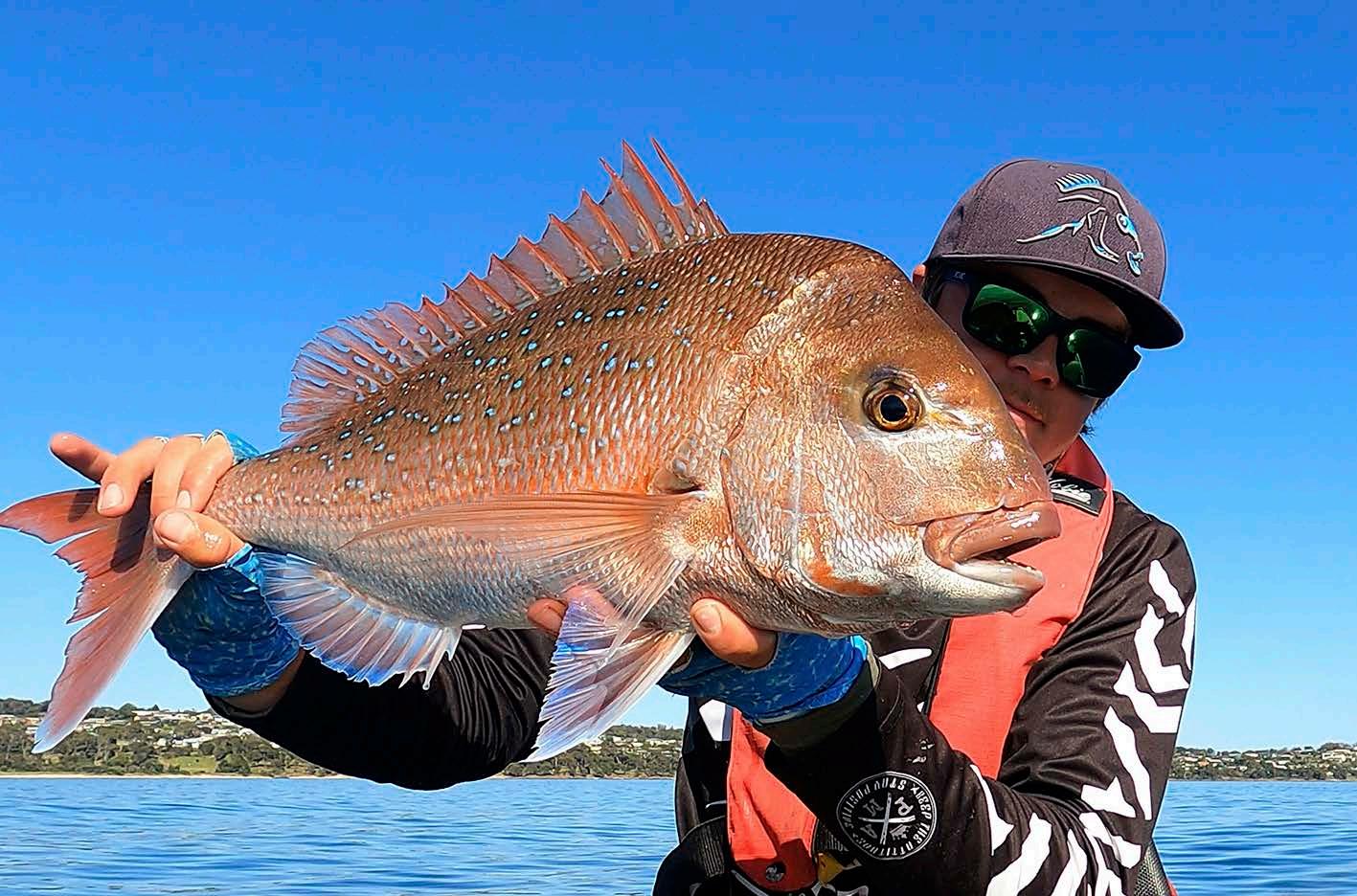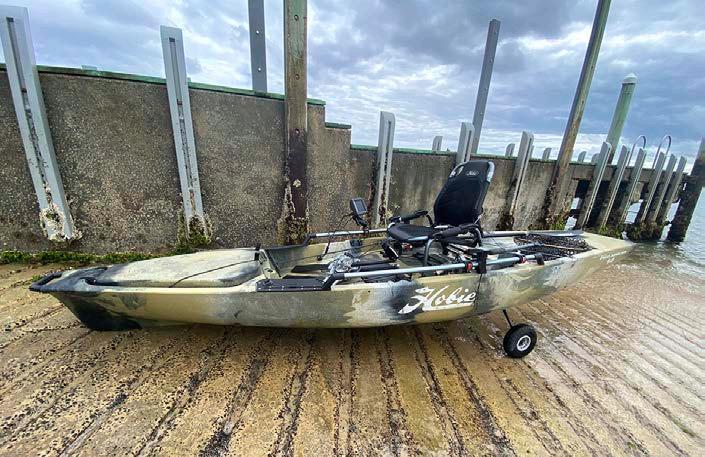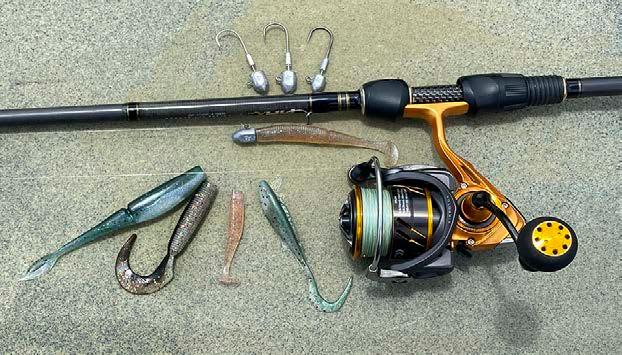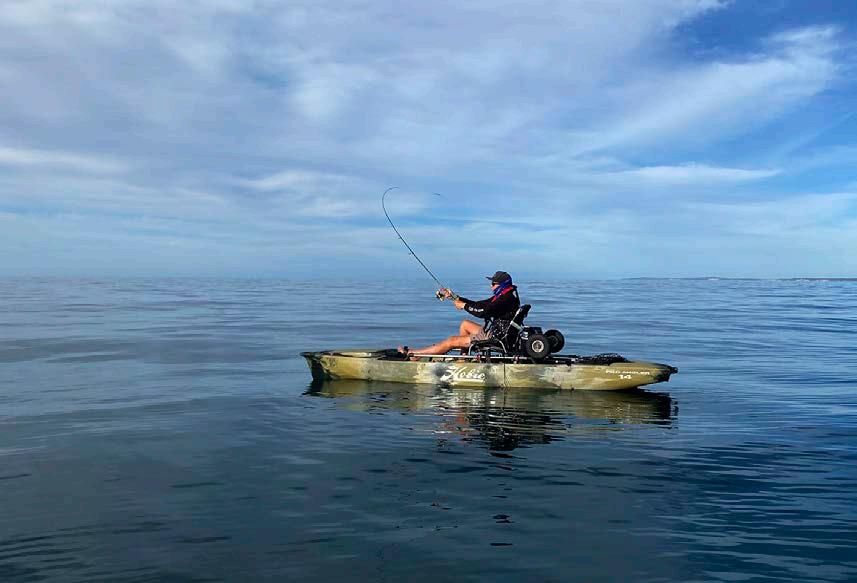
7 minute read
Kayak Snapper
A whole new level
Jonty Kruska
There is no doubt that a kayak is perfectly suited to chasing bream and trout in the estuaries and lakes, but it can also be a great tool for exploring coastal waters in search of the mighty Snapper. Throwing soft plastics from the kayak may not be the most conventional way to target snapper but it can certainly be very rewarding. Although it can be a bit daunting taking the kayak out onto the blue water, with a bit of planning it can be done fairly easily and can produce some great results. Despite some close calls my current stats are, zero flip overs and only three shark sightings which is not too bad in my books.
Preparation and planning
When planning a Snapper mission in the kayak the most obvious thing to take into account is the weather. Although it is largely dependent on the location and direction of the wind and swell, generally heading out when the swell is below half a metre and the wind is less than 20 km/h will keep you pretty dry and comfortable in the kayak. Finding a nice sheltered location to launch and retrieve the kayak can be easier said than done at times, but it is definitely worth having a look about. Even if this means a little extra paddling/peddling to get to your intended fishing location. I don’t read too much into tides and moon phases, if the wind and swell are good enough, I’ll go. Having said that, a couple of hours on either side of high tide have produced the best results for me. An early start to the day is definitely worth it, I’ve found that most bites tend to come before 10 o’clock. This time of day is also generally the calmest and most comfortable time to be out in the kayak.
Kayak setup
After using a few different kayaks since I began kayak fishing, I’ve now been using a Hobie pro angler 14 for a few years and it is by far the best kayak I’ve ever been in. It is super stable and can handle some pretty rough conditions. It also has heaps of room for all the gear you need and the mirage drive pedal system is a game-changer. If you are in the market for a new kayak, I recommend having a look at the Hobie range. A decent sounder is a very useful piece of equipment when chasing Snapper from the kayak. I run a Lowrance elite 7 Ti but any sounder with side imaging and GPS capabilities will do the job. Side imaging is great for finding reefs and likely looking bottom, whilst a good GPS is very useful for marking these areas and helping to create an accurate map of the structure in the area you are fishing. I also like to create a GPS point everywhere I catch a fish and take note of any patterns that begin to emerge after a few trips. The sounder is powered by an FPV 17.5 ah battery which provides ample run time. It is also very compact and lightweight which are important features for any piece of equipment when fishing from a kayak. Another piece of equipment that comes in handy in the kayak is a deep, long-handled net. There are a few reasons for this, one is that the long handle makes it much easier to net fish in the kayak. Another advantage is that having a deep net makes it a lot easier to net Snook which is a common bycatch for me when Snapper fishing. Snook are very toothy fish that are often up around 80 cm in length and thrash around like crazy when beside the kayak. A large, deep net makes it a lot easier to get them under control and results in a lot fewer bite offs besides the kayak. This means less lost gear and less prime Snapper fishing time wasted retying. A deep net also allows the fish to be easily held in the water while setting up to take a picture or getting the scales and brag mat ready. This is better for the fish and also easier for the fisherman not to have a fish kicking around everywhere while trying to set things up. Some quality kayak wheels also make launching and retrieving much easier.

Location
Often the most challenging aspect of kayak fishing is not having the luxury of being able to run between spots if the fishing is slow at your first location. However, the added level of stealth associated with fishing from a kayak can make up for it when targeting Snapper in clear shallow water. Most of the Snapper fishing I do takes place in between 5 and 8 metres of water which is often crystal clear. I focus my attention around the edges of reefs and over areas of broken bottom. In my experience casting too close to the reef will result in catching nothing but Wrasse and too far away from structure often results in only Flathead and Gurnard. Finding the right bottom and knowing where to focus your efforts will go a long
75–115hp FourStroke
Unbridled power, unexpectedly compact, uncompromising reliability, unbelievably fuel efficient. Mercury’s 75–115hp FourStroke Range. Unlike anything the world has ever seen.
way to catching a Snapper. This is where using the sounder to find structure and marking these points is very useful. Creating your own map of structure in the area allows you to come back and target specific areas without having to go over the top of them and find them on the sounder. This coupled with being in a kayak greatly reduces the chance of spooking any fish in the area. As mentioned earlier I also like to create a waypoint wherever a fish is caught. These marks, coupled with the structure marks can paint an interesting picture of the area you are fishing. After a few trips in my local area fishing at Bridport, I began to notice the points of every fish I was catching fell in a straight line. After a little more sounding around, I realised this straight line fell within a corridor of sandy/shelly bottom with patches of reef running up either side. I can now set up to drift through the middle of this corridor and ensure my plastic is spending as much time in the zone as possible. Noticing little patterns like this can improve your chances. Now that I have the area mapped, I rely a lot more on my GPS than the sonar or side imaging.

Gearing up
When chasing Snapper from the kayak I like to take two outfits with me. A pretty standard Snapper outfit and also a much lighter outfit that I would usually use for Bream. My go-to Snapper outfit consists of a 2.1 metre, 3-6kg rod matched up with a 3000 size reel. The reel is loaded up with 8kg braid and a 4-4.5kg leader of around 3-5 metres. Jig head weights will vary depending on wind, current and depth but they are generally between one-quarter of an ounce to a half-ounce, with a 2/0 or 3/0 size hook. Light wire jig heads are great for pinning smaller fish and finicky bites, however, they can straighten on a better fish so I generally use a more heavy-duty jig head. I’ll generally use this outfit first up when the light is still low. Once the sun is a bit higher in the sky or if the bite is really slow I will opt for the lighter outfit. This consists of a 2.1 metre, 1-3kg rod matched with a 2500 size reel. The reel is loaded with 3kg braid and 3kg leader of around 3-5 metres. The jig head I use on this outfit is generally a one-sixth or one-quarter of an ounce, with a size 1 or 1/0 hook. I use an FG knot to connect my leaders and a penny knot for tying on jig heads. Both rods I use are BK Custom rods which are super light and sensitive, yet powerful enough when needed. They are also really comfortable and cast well which is handy when making repeated casts for hours and hours. As for which plastics to use, I’ve caught Snapper on everything from a 2.5-inch grub to a 5-inch jerk shad. My favourite brand at the moment would have to be the Daiwa baitjunkie range. They have a great range of colours, great action and are quite durable. Squid, wrasse, leatherjackets, snook and barracouta are all fairly common in the areas I target snapper and will tear some of the other brands to shreds. Having said this, the Berkley gulp range has worked for me in the past if there aren’t too many other toothy critters about. The plastic I have had the most success on recently has been the 3.2-inch baitjunkie minnow in the bloodworm colour. This is a great size to start with, as both small pan size fish and the slightly larger models will happily inhale it. Generally, I’ll use the larger plastics on the heavier outfit and opt for the smaller sizes on the lighter setup.
Technique
Once I have made it to the area I’m planning on fishing I will usually paddle upwind of the marks on the sounder and drift back over them with the wind at my back. There are two main reasons for this. The first is simply to make longer wind-assisted casts which can make a difference in shallow water on a calm sunny day. The second is to help keep in better contact with the bottom. However, if there is a certain area where I have sounded fish, had bites or caught fish I will fish it facing into the wind so that I can make multiple casts and fish it thoroughly, without drifting over it. The technique is fairly simple, after making a long cast I wait until I make contact with the bottom then give it two or three hops and let it sink back to the bottom. I then repeat this all the way back to the kayak. Once hooked up to a fish the waypoints marked on the sounder come in handy once again. Knowing where the structure is located around you means you can let the fish run if it’s headed for open water or put the brakes on if it is making a run for the reef. This can be the difference between landing a solid fish or getting busted off in the reef. The 180 drive in the Hobie is great for this, allowing you to reverse away from the structure and tow the fish out to open water. It is always worth focussing a few casts around an area where you have just caught a fish as you will often be able to pick up another in quick succession. If you catch a couple of fish in a certain area and the bite goes quiet it can definitely be worth resting the spot for half an hour or an hour and then coming back and giving it another go.


Although chasing shallow water snapper on soft plastics from the kayak may not be the easiest or most productive way of targeting them, it provides a great challenge and is very rewarding when it all comes together. Not to mention a heap of fun.

Jonty Kruska










